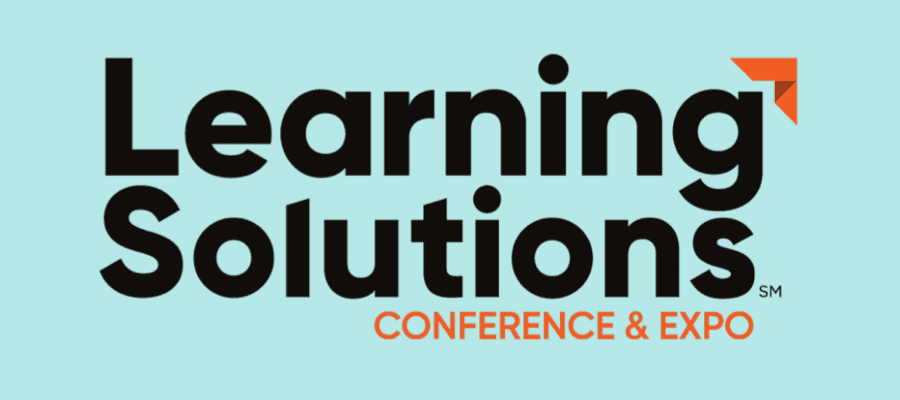Learning Solutions Conference 2023: Key Takeaways
The Challenge
If you’ve ever been to a conference in your line of work, you know the feeling I’m about to describe. Yes, there is the excitement of learning the latest and greatest and wanting to see, do, and learn it ALL—however, it’s coupled with the disappointment and low-key anxiety of knowing there is no way that will happen.

Learning Solutions 2023
The Learning Solutions Conference 2023 was no exception. I had my focused track of learning and the goals I wanted to achieve—and I had my conference agenda with my sessions and backup sessions all picked out.
My main do-or-die goal? Find out what the key players in the learning realm are thinking about, what keeps them up at night, and what they do about it.
Expecting to hear too much about the latest in AI and ed-tech, I came out with three key takeaways that surprised me, but in a happy, relieved, and enlightened way.
Ready for this?
- It’s time to humanize training.
- Learning in the flow of work is not a trend; it’s a must.
- Spark wonder in your training. What’s in it for the learner?
1It's time to humanize training
In the middle of a learning conference, where vendors and session leaders are touting the newest tools in AR, VR, and avatars and auto-features, the pendulum is quietly swinging back to the days of ‘remember when we had an actual trainer?’
The pandemic, working from home, and tech solutions for almost everything have made us all comfortable with tech. But there is growing fatigued around synthetic training, (think: a stock avatar speaking with computer-generated audio voiceovers), that has us pushing back and longing for human connection.
2What does it mean to humanize training?
Of course, this doesn’t mean it’s back to in-person classes for all. However, it does mean that the smart money is on finding ways to bring personal connections to synchronous (everyone learning together), asynchronous (doing it on your own time), and in-person and online training.
This could mean anything from bringing actual two-way, human connection to aspects of your training to simply inserting real video, images or audio into your courses.

3When would you consider humanizing your solution?
Of course, the answer is whenever possible, but when should you try to bring a personal, human aspect to your training? Here is what I gleaned from many of my discussions on the topic:
- When it’s content in the affective realm, you want people to feel something or respond to emotions.
- When it’s essential yet dry content, and you want to engage the learners so they continue watching, reading, and learning
- When you want to encourage learners to follow up with questions
- When you feel you need a little something extra to bring training to life
As instructional designers, how do we do this?
When and how to humanize training
How do we bring a personalized, human feel to an online, asynchronous learning event? Over my many years as a learner and facilitator, I’ve curated a list of what has worked well or what I have wished was present in some of the courses I have interacted with. Maybe some of these will work for you.
1When you want learners to feel something
- Insert real stories/scenarios into your content to contextualize what they are learning
- Add video testimonials or accounts from people doing the work they are being trained on
- Add interview-style audio or video with subject-matter experts in the field
- Add images from real workplaces with actual employees in them
- Embed video that either tells a story or shows a real person explaining the content/feeling/emotion you wish to elicit
2When you want to augment dry content
- Send pre/post training communications (consider short videos!) directly to participants introducing the training and how they should apply what they’ve learned.
- Solicit workplace mentors to drop in on new employees or new learners to follow up with them and ensure they understand the content.
- Add short video introductions of each main training section by an SME or someone experienced and respected in the workplace.

3When you want to encourage engagement
- Schedule post-training Q&A drop-in calls to address questions on the course content
- Follow up with e-mails or post-training boosts for the learners to check in on their progress
- Ask experienced staff to check in on learners to see how they’re making out with the new skill/knowledge/ability
- Include scenarios learners can choose from which relate to specific areas of the workplace relevant to them
3When you want to add a little extra to your content
- Fewer stock images and more imagery from workplaces, including employee images (with their permission, of course!). Hot tip: solicit employees from all work locations to submit work photos to a bank for ease of use as needed.
- when providing contact info, include names, not just departments, when possible
The key takeaway here is to think of how you connect with your learners and what opportunities you have to inject human connection into your learning products.
Marshall McLuhan said, ‘The medium IS the message.’ If we are feeding our learners automated, robotic content—what are we telling them about the value we place on the content we want them to learn?
We could all use more human interaction these days. Delivering a more human learning product is possible even when real humans can’t.


